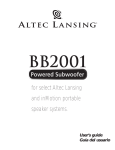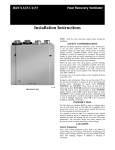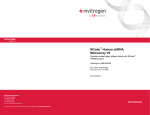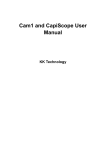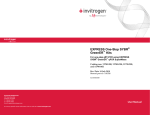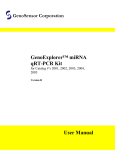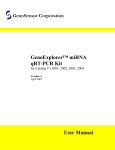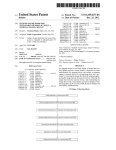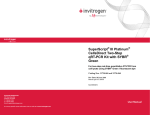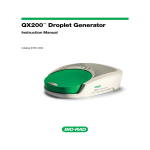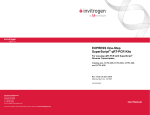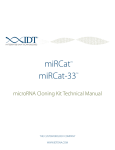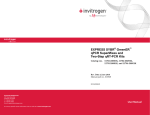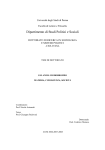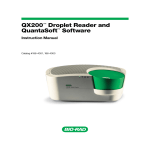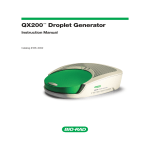Download NCode VILO miRNA cDNA Synthesis Kit and EXPRESS SYBR
Transcript
NCode™ VILO™ miRNA cDNA Synthesis Kit and EXPRESS SYBR® GreenER™ miRNA qRTPCR Kits Catalog nos. A11193-050, A11193-051, and A11193-052 Version A 12 February 2009 A11176 Corporate Headquarters Invitrogen Corporation 1600 Faraday Avenue Carlsbad, CA 92008 T: 1 760 603 7200 F: 1 760 602 6500 E: [email protected] For country-specific contact information visit our web site at www.invitrogen.com User Manual ii Table of Contents Kit Contents and Storage .......................................................................... v Additional Products .................................................................................vi Overview..................................................................................................... 1 Instrument Compatibility ......................................................................... 7 Methods ........................................................................................ 8 Poly(A) Tailing and cDNA Synthesis...................................................... 8 General qPCR Guidelines and Parameters........................................... 12 qPCR SuperMix Universal—Guidelines and Protocols...................... 15 qPCR SuperMix with Premixed ROX—Guidelines and Protocols.................................................................................................... 20 Troubleshooting ....................................................................................... 22 Appendix .................................................................................... 24 Technical Support .................................................................................... 24 Purchaser Notification ............................................................................ 26 References ................................................................................................. 28 iii iv Kit Contents and Storage Kit Components and Storage This manual is for use with the kits listed below. Each kit is shipped on dry ice. Store all components at –20°C for longterm storage. EXPRESS qPCR SuperMixes may be stored at 4–8°C for up to one month. NCode™ VILO™ miRNA cDNA Synthesis Kit (A11193-050) includes components for 50 cDNA synthesis reactions from miRNA, plus the Universal qPCR Primer. Other qPCR reagents must be ordered separately. 10X SuperScript® Enzyme Mix 100 μl 5X Reaction Mix 200 μl 10 μM Universal qPCR Primer 250 μl DEPC-Treated Water 2 ml NCode™ EXPRESS SYBR® GreenER™ miRNA qRT-PCR Kit Universal (A11193-051) includes components for 50 cDNA synthesis reactions and 200 qPCR reactions. EXPRESS SYBR® GreenER™ qPCR SuperMix Universal 5 ml ROX Reference Dye 500 μl NCode™ VILO™ miRNA cDNA Synthesis Kit 50 rxns (see components listed above) (20 μl each) NCode™ EXPRESS SYBR® GreenER™ miRNA qRT-PCR Kit with Premixed ROX (A11193-052) includes components for 50 cDNA synthesis reactions and 200 qPCR reactions, with ROX at a premixed concentration in the qPCR SuperMix. EXPRESS SYBR® GreenER™ qPCR SuperMix with Premixed ROX 5 ml ROX Reference Dye 500 μl NCode™ VILO™ miRNA cDNA Synthesis Kit 50 rxns (see components listed above) (20 μl each) Product Qualification The Certificate of Analysis (CofA) provides detailed quality control information for each product. The CofA is available on our website at www.invitrogen.com/cofa, and is searchable by product lot number, which is printed on each box. v Additional Products Additional Products The NCode™ system is an integrated miRNA expression profiling system that includes miRNA isolation, amplification, purification, quantification, labeling, and array hybridization components. Additional products are available separately from Invitrogen. Ordering information is provided below. For more information, visit our Web site at www.invitrogen.com or contact Technical Support (page 24). Product ™ RNase Away Reagent DNase I, Amplification Grade ® TRIzol Reagent Quant-iT™ RNA Assay Kit ™ Quantity Catalog no. 250 ml 10328-011 100 units 18068-015 100 ml 200 ml 15596-026 15596-018 1 kit Q-33140 Quant-iT DNA Assay Kit, High Sensitivity 1000 assays Q33120 NCode™ miRNA Amplification System 20 reactions MIRAS-20 NCode™ Rapid miRNA Labeling System 20 labeling rxns MIRLSRPD20 NCode™ Rapid Alexa Fluor® 3 miRNA Labeling System 20 labeling rxns MIRLSA3-20 NCode™ Multi-Species miRNA Microarray V2 5 slides MIRA2-05 NCode™ Multi-Species miRNA Microarray Control V2 10 μl MIRAC2-01 NCode ™ Multi-Species miRNA Microarray Probe Set V2 3 × 384-well plates / 500 pmol per well MIRMPS2-01 5 slides MIRAH3-05 4 × 384-well plates / 500 pmol per well MIRHPS3-01 1000 assays Q33130 5 × 1 ml F36915 NCode™ Human miRNA Microarray ™ NCode Human miRNA Microarray Probe Set V3 Quant-iT™ DNA Assay Kit, Broad-Range Fluorescein NIST-Traceable Standard (50 μM) Custom Primers vi visit www.invitrogen.com/oligos Overview System Overview The NCode™ VILO™ miRNA cDNA Synthesis Kit and NCode™ EXPRESS SYBR® GreenER™ miRNA qRT PCR Kits provide qualified reagents for the tailing of microRNAs (miRNAs) and other small RNAs in a total RNA population, synthesis of first-strand cDNA from the tailed RNA, and subsequent detection in real-time quantitative PCR (qPCR). These kits have been optimized for the detection and quantification of miRNA from 100 pg to 1 μg of total RNA, with the amount of starting material ranging as low as 10 pg. Using the NCode™ VILO™ miRNA cDNA Synthesis Kit, the polyadenylation of miRNAs and reverse transcription from the tailed population occur in a single step, for a more streamlined workflow and greater sensitivity. SuperScript™ III Reverse Transcriptase (RT) in the reaction ensures high specificity and high yields of cDNA from small amounts of starting material. EXPRESS SYBR® GreenER™ qPCR SuperMixes include Platinum® Taq DNA polymerase, SYBR® GreenER™ fluorescent dye, MgCl2, heat-labile uracil DNA glycosylase (UDG), dNTPs (with dUTP instead of dTTP), and stabilizers. SYBR® GreenER™ is a novel fluorescent double-stranded DNA binding dye for both higher sensitivity and lower PCR inhibition than other fluorescent double-stranded DNA binding dyes. It can be used on real-time PCR instruments calibrated for SYBR® Green I without any change of filters or settings. • qPCR SuperMix with Premixed ROX: The qPCR SuperMix with premixed ROX includes ROX Reference Dye at a final concentration of 500 nM to normalize the fluorescent signal on instruments that are compatible with this option. • Universal qPCR SuperMix: The Universal SuperMix includes ROX as a separate component for instruments that use ROX at a different concentration or do not require ROX. Continued on next page 1 Overview, continued Advantages of the Kits Workflow Overview The NCode™ kits have the following advantages: • Enable poly(A) tailing of all the small RNAs (including miRNA) in a total RNA sample, and then synthesizing cDNA from the tailed population in a single reaction • The optimal amount of starting material is 100 pg to 1 μg total RNA, and can range as low 10 pg • No proprietary primers or primer-probe assays required for qPCR; you can design your own primer for any miRNA or other small RNA sequence from any species • Allows profiling of small RNAs, miRNAs, or mRNAs from a single cDNA synthesis reaction • Can discriminate between miRNAs that differ by a single nucleotide, for profiling closely related templates • The Universal qPCR Primer included in the NCode™ VILO™ miRNA cDNA Synthesis Kit gives you the flexibility to order your qPCR detection reagents separately, if desired • EXPRESS SYBR® GreenER™ qPCR SuperMixes included in the qRT-PCR kits ensure optimal sensitivity and performance in qPCR using a novel fluorescent dsDNA binding dye • Heat-labile UDG and dUTP in the qPCR SuperMixes prevent amplification of carryover PCR products between reactions; the heat-labile form of the enzyme is completely inactivated during normal qPCR cycling • Designed and developed as part of the comprehensive NCode™ system, which includes the NCode™ miRNA Microarrays V2 and V3, Probe Sets V2 and V3, Control V2, Rapid miRNA Labeling System, and Amplification System Following isolation of total RNA, all the miRNAs in the sample are polyadenlyated and reverse-transcribed using poly A polymerase, ATP, SuperScript™ III RT, and a speciallydesigned universal RT primer in a single reaction The first-strand cDNA is ready for analysis in qPCR using EXPRESS SYBR® GreenER™ detection reagents, the Universal qPCR Primer provided in the kit, and a forward primer designed by the user that targets the specific miRNA sequence of interest. Continued on next page 2 Overview, continued Workflow Diagram 5´ 3´ miRNA in a total RNA sample Poly(A) tailing plus first-strand cDNA synthesis with SuperScript®III RT and a universal RT primer Poly(A) tail 3´ miRNA 5´ First-strand cDNA 5´ 3´ Universal RT Primer qPCR with EXPRESS SYBR®GreenER SuperMix, the Universal Primer, and an miRNA-specific forward primer miRNA-specific Primer 3´ 5´ Universal qPCR Primer Data analysis Forward Primer Design for qPCR ROX Reference Dye The Universal qPCR Primer provided in the VILO™ kit is used as the reverse primer in the qPCR reaction. The forward qPCR primer is specific for the miRNA sequence of interest and must be ordered separately by the user. To design the forward primer, we recommend visiting the NCode™ miRNA Database at http://escience.invitrogen.com/ncode and searching for the mature miRNA name, accession number, or sequence of interest. Click on the link in the search results to view the record for that miRNA, which contains the suggested qPCR primer sequence(s). You can then order a sequence directly from Invitrogen by clicking on the primer link in the miRNA record. Please note that not all of the primer sequences in the database have been bench validated. For additional forward primer design guidelines, see the recommendations on page 13. ROX Reference Dye is either premixed in the qPCR SuperMix or included as a separate component to normalize the fluorescent signal between reactions for instruments that are compatible with this option. Continued on next page 3 Overview, continued Heat-labile Uracil DNA Glycosylase (UDG) MicroRNAs and Small RNAs Heat-labile UDG and dUTP in the qPCR SuperMixes prevent the reamplification of carryover PCR products between reactions (Lindahl et al., 1977; Longo et al., 1990). dUTP ensures that any amplified DNA will contain uracil, while heat-labile UDG removes uracil residues from singleor double-stranded DNA. The heat-labile form of UDG is completely inactivated at temperatures of 50°C and higher and will not degrade amplicons following qPCR. MicroRNAs (miRNAs) are a recently discovered class of small, ~19–23-nucleotide non-coding RNA molecules that several groups have hypothesized may contribute to eukaryotic complexity (Bentwich et al., 2005; Imanishi et al., 2004; Okazaki et al., 2002). They are cleaved from hairpin precursors and are believed play an important role in translation regulation of target mRNAs by binding to partially complementary sites in the 3´ untranslated regions (UTRs) of the message (Lim, 2003). Though hundreds of miRNAs have been discovered, little is known about their cellular function. They have been implicated in regulation of developmental timing and pattern formation (Lagos-Quintana et al., 2001), restriction of differentiation potential (Nakahara & Carthew, 2004), regulation of insulin secretion (Stark et al., 2003), and genomic rearrangements (John et al., 2004). Several unique physical attributes of miRNAs—including their small size, lack of poly-adenylated tails, and tendency to bind their mRNA targets with imperfect sequence homology—have made them elusive and challenging to study. In addition, strong conservation between miRNA family members means that any detection technology must be able to distinguish between ~22-base sequences that differ by only 1–2 nucleotides. Recent advances in microarray and qPCR detection have enabled the use of these technologies for miRNA screening. With the maturation of deep-sequencing platforms, many other novel classes of small RNA have been discovered, including snoRNA (Maden, 1990), piRNA (Lau et al., 2006), and promoter-associated RNA. Although the function of these RNAs remains unclear, their validation and characterization is critical to gene expression research. Continued on next page 4 Overview, continued Other Products in the NCode™ System The following products are available separately from Invitrogen (for ordering information, see page vi): • The NCode™ Multi-Species miRNA Microarray V2 consists of 5 Corning® Epoxide-Coated Glass Slides, each printed with optimized probe sequences targeting all of the known mature miRNAs in miRBase, Release 9.0 (http://microrna.sanger.ac.uk), for human, mouse, rat, D. melanogaster, C. elegans, and Zebrafish. The probes were designed using an algorithm that generates miRNA sequences with enhanced hybridization properties (Goff et al., 2005). Each slide comes blocked and ready to use. • The NCode™ Human miRNA Microarray V3 consists of 5 Corning® Epoxide-Coated Glass Slides, each printed with optimized probe sequences for all known mature human miRNAs in the miRBase Sequence Database, Release 10.0 (http://microrna.sanger.ac.uk), as well as putative novel human miRNAs discovered through deep sequencing and validated by qRT-PCR and array profiling. You can use each microarray to screen dyelabeled human miRNA samples. • The NCode™ Multi-Species miRNA Microarray Probe Set V2 includes the probe sequences provided on the V2 microarray, dried down in 384-well plates at 500 pmoles per well and ready for printing on standard DNA microarray surfaces. • The NCode™ Human miRNA Microarray Probe Set V3 includes probes provided on the V3 microarray, dried down in 384-well plates at 500 pmoles per well and ready for printing. • The NCode™ Rapid miRNA Labeling System is a robust and efficient system for labeling RNA samples and hybridizing the labeled miRNA to NCode™ microarrays for expression profiling analysis. Using this kit, you ligate a DNA polymer labeled with highly fluorescent Alexa Fluor® dye molecules to a total RNA sample, and then hybridize the labeled miRNA in the sample to an array. The system is designed to ensure maximum signal and strong signal correlations. Product list continued on next page Continued on next page 5 Overview, continued Other Products in the NCode™ System, continued Materials Supplied by the User 6 Product list continued from previous page • The NCode™ miRNA Amplification System is a robust system for amplifying sense RNA molecules from minute quantities (<30 ng) of miRNA. The system provides consistent and accurate ≥1000-fold amplification while preserving the relative abundance of the miRNA sequences in the original sample, allowing you to compare relative quantities across experiments. • The NCode™ Multi-Species miRNA Microarray Control V2 is a synthetic 22-nucleotide miRNA sequence that has been designed and screened as a positive control for use with NCode™ system. It works with NCode™ V2 and V3 microarrays. This control sequence has been tested for cross-reactivity with endogenous miRNAs from model organisms, and is provided at a concentration compatible with endogenous miRNA expression levels. The following items are supplied by the user: • Total RNA, isolated by a method such as TRIzol® Reagent that preserves low-molecular-weight (LMW) RNA • A forward qPCR primer specific for the miRNA of interest • Microcentrifuge • RNase-free pipette tips • 1.5-ml RNase-free microcentrifuge tubes • Disposable gloves • Ice • qPCR instrument • Appropriate PCR plates/tubes for instrument • Optional: Normalization dye for instruments that do not use ROX Instrument Compatibility qPCR SuperMix Universal qPCR SuperMix with Premixed ROX EXPRESS SYBR® GreenER™ qPCR SuperMix Universal includes ROX Reference Dye as a separate tube, and can be used with a wide range of real-time instruments, including the following: • Applied Biosystems: 7900HT, 7300, 7500, StepOne™, StepOnePlus™, GeneAmp® 5700, and PRISM® 7000 and 7700 • Bio-Rad/MJ Research: iCycler® iQ, iQ5, and MyiQ™; DNA Engine Opticon® and Opticon® 2; and Chromo4™ Real-Time Detector • Cepheid: Smart Cycler® • Corbett Research: Rotor-Gene™ 3000 • Eppendorf: Mastercycler® ep realplex • Roche: LightCycler® 480 • Stratagene: Mx3000P™, Mx3005P™, and Mx4000® EXPRESS SYBR® GreenER™ qPCR SuperMix with Premixed ROX can be used with real-time instruments that are compatible with ROX Reference Dye at a final concentration of 500 nM. These include the following Applied Biosystems instruments: • 7900HT • 7300 • StepOne™ • GeneAmp® 5700 • PRISM® 7000 and 7700 7 Methods Poly(A) Tailing and cDNA Synthesis Introduction This section provides guidelines and a protocol for poly(A) tailing of all the miRNAs and other small RNAs in a total RNA sample and then synthesizing cDNA from the tailed population in a single reaction. Mixes Provided in the Kit The NCode™ VILO™ miRNA cDNA Synthesis Kit includes two mixes that are used for the tailing/cDNA synthesis reaction: The 10X SuperScript® Enzyme Mix includes SuperScript® III RT, RNaseOUT™ Recombinant Ribonuclease Inhibitor, and a proprietary helper protein. The 5X Reaction Mix includes poly A polymerase, ATP, a universal RT primer, MgCl2, and dNTPs in an optimized buffer formulation. Isolating Total RNA To isolate total RNA, we recommend TRIzol® Reagent, which preserves the low-molecular-weight (LMW) RNA in the sample (see page vi for ordering information). Enrichment for small RNAs is typically not necessary, and may result in the loss of sample. Important: Do not use the PureLink™ Micro-to-Midi™ Total RNA Purification System to isolate total RNA samples, as this purification method does not preserve LMW RNA. Total RNA Guidelines • The optimal amount of starting material is 100 pg to 1 μg of total RNA, though we have obtained good results with as little as 10 pg of total RNA • High-quality, intact RNA is essential for accurate quantification • DNase I, Amplification Grade, may be used to eliminate genomic DNA contamination from the total RNA (see page vi for ordering information). Continued on next page 8 Poly(A) Tailing and cDNA Synthesis, continued General Handling of RNA When working with RNA: • Use proper microbiological aseptic technique. • Wear latex gloves while handling reagents, materials, and RNA samples to prevent RNase contamination. • Use disposable, individually wrapped, sterile plasticware for all procedures. • Use aerosol-resistant pipette tips. • Dedicate a separate set of pipettes, buffers, and enzymes for RNA work. • Use RNase-free microcentrifuge tubes. To decontaminate untreated tubes, soak overnight in a 0.01% (v/v) aqueous solution of diethylpyrocarbonate (DEPC), rinse with sterile distilled water, and autoclave. RNase Away™ Reagent, a non-toxic solution available from Invitrogen, can be used to remove RNase contamination from surfaces. Determining Total RNA Quality Total RNA quality can be analyzed using a bioanalyzer such as the Agilent 2100 bioanalyzer with an RNA LabChip®. Alternatively, total RNA can be analyzed by agarose gel electrophoresis. RNA isolated using TRIzol® Reagent typically has a 28S-to-18S band ratio of >1.5. RNA is judged to be intact if discreet 28S and 18S ribosomal RNA bands are observed. Continued on next page 9 Poly(A) Tailing and cDNA Synthesis, continued Determining Total RNA Yield Total RNA can be quantitated using the Quant-iT™ RNA Assay Kit or UV absorbance at 260 nm. Quant-iT™ RNA Assay Kit The Quant-iT™ RNA Assay Kit provides a rapid, sensitive, and specific method for RNA quantitation with minimal interference from DNA, protein, or other common contaminants that affect UV absorbance readings. The kit contains a quantitation reagent and pre-diluted standards for a standard curve. The assay is performed in a microtiter plate and can be read using a standard fluorescent microplate reader. UV Absorbance 1. Dilute an aliquot of the total RNA sample in 10 mM Tris-HCl, pH 7.5. Mix well. Transfer to a cuvette (1-cm path length). Note: The RNA must be in a neutral pH buffer to accurately measure the UV absorbance. 2. Determine the OD260 of the solution using a spectrophotometer blanked against the buffer alone (10 mM Tris-HCl, pH 7.5). 3. Calculate the amount of total RNA using the following formula: Total RNA (μg) = OD260 × [40 μg/(1 OD260 × 1 ml)] × dilution factor × total sample volume (ml) Example: Total RNA was eluted in water in a total volume of 150 μl. A 40-μl aliquot of the eluate was diluted to 500 μl in 10 mM Tris-HCl, pH 7.5. An OD260 of 0.188 was obtained. The amount of RNA in the sample is: Total RNA (μg) = 0.188 × [40 μg/(1 OD260 × 1 ml)] × 12.5 × 0.15 = 14.1 μg Continued on next page 10 Poly(A) Tailing and cDNA Synthesis, continued Reaction Guidelines The 37°C incubation for 60 minutes combines both poly(A) tailing of miRNAs/small RNAs with cDNA synthesis of the tailed population. The reaction is terminated with the 95°C incubation. Poly(A) Tailing and cDNA Synthesis Protocol The following reaction volume may be scaled as needed up to 100 μl. 1. For a single reaction, combine the following components in a tube on ice. For multiple reactions, prepare a master mix without RNA. 5X Reaction Mix 10X SuperScript® Enzyme Mix Total RNA (100 pg to 1 μg) DEPC-treated water 4 μl 2 μl X μl to 20 μl 2. Cap the tube, gently vortex to mix, and centrifuge briefly to collect the contents. 3. Incubate tube at 37°C for 60 minutes. 4. Terminate the reaction at 95°C at 5 minutes. 5. Hold the reaction at 4°C until use. Use the undiluted cDNA in qPCR. For long-term storage, store the cDNA at –20°C. 11 General qPCR Guidelines and Parameters Introduction This section provides general qPCR guidelines, as well as guidance on designing the forward qPCR primer that is specific for the miRNA sequence of interest. qPCR Setup and Conditions • Maintain a sterile environment when handling the cDNA to avoid any contamination from DNases • Make sure all equipment that comes in contact with the cDNA is sterile, including pipette tips and microcentrifuge tubes • qPCR reaction volumes can be scaled up to 100 μl, depending on the instrument. • For instrument-specific guidelines, see the section for each type of SuperMix. Melting Curve Analysis Melting curve analysis should always be performed following real-time qPCR to identify the presence of primer dimers and analyze the specificity of the reaction. Program your instrument for melting curve analysis using the instructions provided with your specific instrument. Amount of cDNA You can use up to 10% of undiluted cDNA in the qPCR reaction (e.g., for a 20-μl qPCR, use up to 2 μl of undiluted cDNA). Reverse qPCR Primer Use the Universal qPCR Primer provided as a separate tube in the NCode™ VILO™ kit as the reverse primer in the qPCR reaction. If you are using archived cDNA from the old NCode™ miRNA First-Strand cDNA Synthesis Kit (catalog no. MIRC10 or MIRC-50), you must use the Universal qPCR Primer provided with that kit in the qPCR reaction. cDNA generated using that kit is not compatible with the new Universal qPCR Primer in the current NCode™ VILO™ Kit. Continued on next page 12 General qPCR Guidelines and Parameters, continued Forward qPCR Primer Designs— NCode™ miRNA Database To design the miRNA-specific forward primer , we recommend starting with the qPCR primer designs provided in the NCode™ miRNA Database. Go to http://escience.invitrogen.com/ncode and search for the mature miRNA name, accession number, or sequence of interest. Click on the link in the search results to view the record for that miRNA, which contains the suggested qPCR primer sequence(s). You can then order a sequence directly from Invitrogen by clicking on the primer link in the miRNA record. Please note that not all of the primer sequences in the miRNA database have been bench validated. Additional Forward qPCR Primer Design Criteria If you choose to design the miRNA-specific forward qPCR primer yourself, keep in mind the following guidelines: • Start with the entire miRNA sequence (in DNA primer form, i.e., T’s in place of U’s). • Use a primer design program such as OligoPerfect™ (available on the Web at www.invitrogen.com/oligos) or Vector NTI™ to determine the primer Tm, 3’ stability, self complementarity, and end-self complementarity. • The optimal primer Tm is 60°C. • If the Tm for the entire miRNA sequence is too low, try adding non-templated bases to the 5’ end of the primer (usually G’s and C’s in random combinations, although A’s and T’s may also be used). Also, adding one or more A’s to the 3’ end of the primer is acceptable and sometimes helps the primer overcome high 3’ stability or self-complementarity issues to pass the primer checker. • If the Tm is too high, truncate from the 5’ end of the primer only. Truncating from the 3’ end will lose specificity to the target due to the 3’ variability of miRNAs. To achieve an optimal Tm of around 60°C, you can truncate bases from the 5’ end while at the same time adding A’s to the 3’ end. Continued on next page 13 General qPCR Guidelines and Parameters, continued Forward Primer Design Examples Example 1: 1. The Tm for the entire miR-106b sequence as a primer (TAAAGTGCTGACAGTGCAGAT) is 56.2°C. 2. Adding combinations of G’s and C’s to the 5’ end of the miR results in the following Tm’s: GGTAAAGTGCTGACAGTGCAGAT = Tm 60.7°C CCTAAAGTGCTGACAGTGCAGAT = Tm 60.9°C GCTAAAGTGCTGACAGTGCAGAT = Tm 61.0°C 3. All of these designs work when tested with a humanpooled tissue cDNA sample. Example 2: 1. The Tm for the entire miR-324 sequence as a primer (CGCATCCCCTAGGGCATTGGTGT) is 71.8°C. 2. Bases were truncated from the 5’ end until the Tm was in an acceptable range. A few more truncated primers were designed with A’s on the 3’ end to bring the Tm closer to 60°C. ATCCCCTAGGGCATTGGTGT TCCCCTAGGGCATTGGTGT CCCCTAGGGCATTGGTGT CCCCTAGGGCATTGGTGTA CCCCTAGGGCATTGGTGTAA 3. Ordering the Forward qPCR Primer 14 Tm 62.7 Tm 62.6 Tm 60.7 Tm 60.7 Tm 62.0 When these sequences were tested, the bottom two primer designs worked best. Adding an A or two A’s while truncating from the 5’ end adds more specificity back to the primer design, helping it anchor to the poly(T) tail in the cDNA. After you have designed the miRNA-specific forward primer, you can order it from Invitrogen by visiting www.invitrogen.com/oligos. qPCR SuperMix Universal—Guidelines and Protocols Introduction This section provides guidelines and protocols for using the EXPRESS SYBR® GreenER™ qPCR SuperMix Universal. Additional Materials Required The following items are supplied by the user: ROX Reference Dye Concentration • miRNA-specific forward primer • Microcentrifuge • qPCR instrument • PCR tubes/plates ROX Reference Dye is supplied as a separate tube in the Universal Kit. ROX is recommended for fluorescence normalization on Applied Biosystems instruments, and is optional for Stratagene and Eppendorf instruments. It is not required on other instruments. ROX is composed of a glycine conjugate of 5-carboxy-X-rhodamine, succinimidyl ester and is supplied at a concentration of 25 μM. Use the following table to determine the amount of 25-μM ROX to use with a particular instrument: Instrument AB 7300, 7900HT, StepOne™, and PRISM® 7000 and 7700 AB 7500 and StepOnePlus™; Stratagene Mx3000P™, Mx3005P™, and Mx4000® Amount of ROX per 20-μl reaction Effective Fold Final ROX Concentration of Concentration 25-μM ROX 0.4 μl 50X 500 nM 0.04 μl 500X 50 nM Continued on next page 15 qPCR SuperMix Universal, continued Fluorescein for Bio-Rad iCycler® Instruments Bio-Rad iCycler® instruments require the collection of “well factors” before each run to compensate for any instrument or pipetting non-uniformity. Well factors for SYBR® GreenER™ experiments are calculated using an additional fluorophore, fluorescein. Well factors are collected using either a separate plate containing fluorescein in each well (External Well Factors) or the experimental plate with fluorescein spiked into the qPCR master mix (Dynamic Well Factors). You must select the method when you start each run using the iCycler®. Fluorescein is available separately from Bio-Rad, or Fluorescein NIST-Traceable Standard is available from Invitrogen as a 50-μM solution (see page vi for ordering information). External Well Factors: The Bio-Rad iCycler® instruction manual provides instructions on preparing and using the External Well Factor plate. The iCycler® will automatically insert a 3-cycle program before your experimental cycling program to perform the External Well Factor reading. Note: The iCycler® iQ5 and MyiQ™ systems allow you to save the data from an External Well Factor reading as a separate file, which can then be referenced for future readings. Select the Persistent Well Factor setting when you are entering the cycling program to reference this saved file. Dynamic Well Factors: For Dynamic Well Factor readings, the user must add fluorescein to the qPCR master mix at a final concentration of 10–20 nM. Consult your Bio-Rad iCycler® instruction manual for details. Note that if you select the Dynamic Well Factor option, the instrument will automatically insert a 90-second incubation at 95°C before the initial 95°C denaturation step. Continued on next page 16 qPCR SuperMix Universal, continued General Cycling Programs The following cycling programs have been developed as a general starting point when using EXPRESS SYBR® GreenER™ qPCR SuperMix Universal. The fast cycling program was developed using the AB 7500 in Fast mode. Note: This mix is highly robust and can be used with a wide range of cycling programs on different instruments. If you have an alternative program that you want to use, test it with this mix. Fast Cycling Program (developed using the AB 7500 in Fast mode) 95°C for 20 seconds 40 cycles of: 95°C for 1 second 60°C for 20 seconds Optional: Melting curve analysis: 60°C–95°C (refer to instrument manual for specific programming) Standard Cycling Program 50°C for 2 minutes (UDG incubation) 95°C for 2 minutes 40 cycles of: 95°C for 15 seconds 60°C for 1 minute Optional: Melting curve analysis: 60°C–95°C (refer to instrument manual for specific programming) Continued on next page 17 qPCR SuperMix Universal, continued Roche LightCycler® 480 Cycling Program Program Name Pre-incubation Amplification Melting Curve Cooling Target (°C) Pre-incubation 95 Amplification 95 Primer Tm minus 5°C (2) 72 Melting Curve 95 65 97 The following cycling program is specific for the Roche LightCycler® 480 with a 96-well or 384-well plate when using EXPRESS SYBR® GreenER™ qPCR SuperMix Universal. For detailed programming instructions, consult the instrument manual. Cycles 1 40–45 1 1 Analysis Mode None Quantification Melting Curves None Ramp Rate (°C/s) 96-well 384-well Acquisition Mode Hold Time (hh:mm:ss) None 00:05:00 4.4 (or 2.0)(1) 4.8 None None 00:00:10 00:00:05– 00:00:20 (3) 00:00:05– 00:00:20 (3) 4.4 (or 2.0)(1) 2.2 4.8 2.5 4.4 (or 2.0)(1) 4.8 2.0 2.0 — 2.0 2.0 — Single None None Continuous (5–10 acquisitions per °C 00:00:05 00:01:00 — Cooling 40 None 00:00:10 2.0 2.0 (1) A ramp rate of 2.0°C/s is recommended for reaction volumes of 50 μl or greater. (2) The annealing temperature will vary depending on the melting temperature (Tm) of the primers. Use primer Tm minus 5°C as a general starting point. (3) Longer annealing and extension times may result in greater precision in target quantification. 384-Well Plate Volumes For 384-well plates, we recommend a maximum reaction volume of 10 μl per well. Continued on next page 18 qPCR SuperMix Universal, continued qPCR Protocol Use the protocol below as a general starting point for qPCR with EXPRESS SYBR® GreenER™ qPCR SuperMix Universal. Scale the reaction volume as needed for your real-time instrument. ROX is recommended for Applied Biosystems instruments and optional for Stratagene and Eppendorf instruments (see page 15). Bio-Rad iCycler® instruments use fluorescein instead of ROX for Dynamic Well Factor readings (see page 16). 1. Set up reactions on ice. Volumes for a 20-μl reaction size are provided; component volumes can be scaled as needed (up to 10% of the qPCR reaction may be undiluted cDNA). For 384-well plates, we recommend a maximum reaction volume of 10 μl per well. Always prepare a master mix of common components for multiple reactions. 20-μl rxn EXPRESS SYBR® GreenER™ qPCR SuperMix Universal 10 μl 10 μM miRNA-specific forward primer (200 nM final) 0.4 μl 10 μM Universal qPCR Primer (200 nM final) 0.4 μl ROX Reference Dye (25 μM)* 0.4 μl/0.04** μl cDNA (up to 2 μl undiluted) X μl DEPC-treated water to 20 μl *Consult instrument documentation. The iCycler® uses fluorescein instead of ROX for Dynamic Well Factor readings (10–20 nM final concentration; see page 16). **See the table on page 15 for the amount/concentration of ROX to use for your specific instrument. 2. Prepare no-template control (NTC) reactions to test for DNA contamination of the enzyme/primer mixes. 3. Cap or seal each PCR tube/plate, and gently mix. Make sure that all components are at the bottom of the tube/plate; centrifuge briefly if needed. 4. Place reactions in a real-time instrument programmed as described on the previous pages. Collect data and analyze results. 5. Optional: The specificity of the PCR products can be checked by agarose gel electrophoresis. 19 qPCR SuperMix with Premixed ROX—Guidelines and Protocols Introduction This section provides guidelines and protocols for using the EXPRESS SYBR® GreenER™ qPCR SuperMix with Premixed ROX. Additional Materials Required The following items are supplied by the user: • miRNA-specific forward primer • Microcentrifuge • qPCR instrument • PCR tubes/plates Premixed ROX Concentration ROX Reference Dye is included in the SuperMix at a final concentration of 500 nM, which is compatible with Applied Biosystems 7900HT, 7300, StepOne™, GeneAmp® 5700, and PRISM® 7000 and 7700. Cycling Programs The following general cycling programs have been developed as a starting point when using the EXPRESS SYBR® GreenER™ qPCR SuperMix with Premixed ROX on various instruments. The fast cycling program is designed for the AB 7900HT and StepOne™. Note: This mix is highly robust and can be used with a wide range of cycling programs on different instruments. If you have an alternative program that you want to use, test it with this mix. Fast Cycling Program (developed using the AB 7500 in Fast mode) 95°C for 20 seconds 40 cycles of: 95°C for 1 second 60°C for 20 seconds Optional: Melting curve analysis: 60°C–95°C (refer to instrument manual for specific programming) Standard Cycling Program 50°C for 2 minutes (UDG incubation) 95°C for 2 minutes 40 cycles of: 95°C for 15 seconds 60°C for 1 minute Optional: Melting curve analysis: 60°C–95°C (refer to instrument manual for specific programming) Continued on next page 20 qPCR SuperMix with Premixed ROX, continued 384-Well Plate Volumes For 384-well plates, we recommend a maximum reaction volume of 10 μl per well. qPCR Protocol Use the protocol below as a general starting point for qPCR with EXPRESS SYBR® GreenER™ qPCR SuperMix with Premixed ROX. Scale the reaction volume as needed for your real-time instrument. 1. Set up reactions on ice. Volumes for a 20-μl reaction size are provided; component volumes can be scaled as needed (up to 10% of the qPCR reaction may be undiluted cDNA). For 384-well plates, we recommend a maximum reaction volume of 10 μl per well. Always prepare a master mix of common components for multiple reactions. 20-μl rxn EXPRESS SYBR® GreenER™ qPCR SuperMix with Premixed ROX 10 μl 10 μM miRNA-specific forward primer (200 nM final) 0.4 μl 10 μM Universal qPCR Primer (200 nM final) 0.4 μl cDNA (up to 2 μl undiluted) X μl DEPC-treated water to 20 μl 2. Prepare no-template control (NTC) reactions to test for DNA contamination of the enzyme/primer mixes. 3. Cap or seal each PCR tube/plate, and gently mix. Make sure that all components are at the bottom of the tube/plate; centrifuge briefly if needed. 4. Place reactions in a real-time instrument programmed as described on the previous page. Collect data and analyze results. 5. Optional: The specificity of the PCR products can be checked by agarose gel electrophoresis. 21 Troubleshooting Problem Cause Solution Signals are present in no-template controls, and/or multiple peaks are present in the melting curve graph Reagents are contaminated by nucleic acids Use melting curve analysis and/or run the PCR products on a 4% agarose gel after the reaction to identify contaminants. Take standard precautions to avoid contamination when preparing your PCR reactions. Ideally, amplification reactions should be assembled in a DNA-free environment. We recommend using aerosol-resistant barrier tips. Primer dimers or other primer artifacts are present Use melting curve analysis to identify primer dimers. We recommend using validated predesigned primer sets or design primers using dedicated software programs or primer databases. Primer contamination or truncated or degraded primers can lead to artifacts. Check the purity of your primers by gel electrophoresis. The protocol was not followed correctly Verify that all steps have been followed and the correct reagents, dilutions, volumes, and cycling parameters have been used. Template contains inhibitors, nucleases, or proteases, or has otherwise been degraded. Purify or re-purify your template. Primer design is suboptimal Verify your primer selection. We recommend using validated predesigned primers or design primers using dedicated software programs or primer databases. No PCR product is evident, either in the qPCR graph or on a gel Continued on next page 22 Troubleshooting, continued Problem Cause PCR product is qPCR instrument evident on a gel, but settings are not in the qPCR incorrect graph PCR efficiency is above 110% PCR efficiency is below 90% Solution Confirm that you are using the correct instrument settings (dye selection, reference dye, filters, and acquisition points). Problems with your specific qPCR instrument See your instrument manual for tips and troubleshooting. Template contains inhibitors, nucleases, or proteases, or has otherwise been degraded. Purify or re-purify your template. Inhibitors in the template may result in changes in PCR efficiency between dilutions Too much sample added to reactions Decrease the concentration of cDNA; see the guidelines for cDNA concentration on page 12 Nonspecific products may be amplified. Use melting curve analysis if possible, and/or run the PCR products on a 4% agarose gel after the reaction to identify contaminants. Suboptimal primer design may lead to nonspecific products. Use validated predesigned primers or design primers using dedicated software programs or primer databases. The PCR conditions are suboptimal Verify that the reagents you are using have not been freeze-thawed multiple times and have not remained at room temperature for too long. Verify that the amount of primers you are using is correct. 23 Appendix Technical Support World Wide Web Contact Us Visit the Invitrogen website at www.invitrogen.com for: • Technical resources, including manuals, vector maps and sequences, application notes, MSDSs, FAQs, formulations, citations, handbooks, etc. • Complete technical support contact information • Access to the Invitrogen Online Catalog • Additional product information and special offers For more information or technical assistance, call, write, fax, or email. Additional international offices are listed on our website (www.invitrogen.com). Corporate Headquarters: Invitrogen Corporation 1600 Faraday Avenue Carlsbad, CA 92008 USA Tel: 1 760 603 7200 Tel (Toll Free): 1 800 955 6288 Fax: 1 760 602 6500 E-mail: [email protected] Japanese Headquarters: Invitrogen Japan LOOP-X Bldg. 6F 3-9-15, Kaigan Minato-ku, Tokyo 108-0022 Tel: 81 3 5730 6509 Fax: 81 3 5730 6519 E-mail: [email protected] European Headquarters: Invitrogen Ltd Inchinnan Business Park 3 Fountain Drive Paisley PA4 9RF, UK Tel: +44 (0) 141 814 6100 Tech Fax: +44 (0) 141 814 6117 E-mail: [email protected] MSDS Material Safety Data Sheets (MSDSs) are available on our website at www.invitrogen.com/msds. Certificate of Analysis The Certificate of Analysis (CofA) for this product is available on our website by product lot number at www.invitrogen.com/cofa. Continued on next page 24 Technical Support, continued Limited Warranty Invitrogen is committed to providing our customers with highquality goods and services. Our goal is to ensure that every customer is 100% satisfied with our products and our service. If you should have any questions or concerns about an Invitrogen product or service, please contact our Technical Service Representatives. Invitrogen warrants that all of its products will perform according to the specifications stated on the certificate of analysis. The company will replace, free of charge, any product that does not meet those specifications. This warranty limits Invitrogen Corporation’s liability only to the cost of the product. No warranty is granted for products beyond their listed expiration date. No warranty is applicable unless all product components are stored in accordance with instructions. Invitrogen reserves the right to select the method(s) used to analyze a product unless Invitrogen agrees to a specified method in writing prior to acceptance of the order. Invitrogen makes every effort to ensure the accuracy of its publications, but realizes that the occasional typographical or other error is inevitable. Therefore Invitrogen makes no warranty of any kind regarding the contents of any publications or documentation. If you discover an error in any of our publications, please report it to our Technical Service Representatives. Invitrogen assumes no responsibility or liability for any special, incidental, indirect or consequential loss or damage whatsoever. The above limited warranty is sole and exclusive. No other warranty is made, whether expressed or implied, including any warranty of merchantability or fitness for a particular purpose. 25 Purchaser Notification Limited Use Label License No. 14: Direct Inhibition by Anti-polymerase Antibodies Licensed to Invitrogen Corporation, under U.S. Patent Nos. 5,338,671; 5,587,287, and foreign equivalents for use in research only. Limited Use Label License No. 5: Invitrogen Technology The purchase of this product conveys to the buyer the nontransferable right to use the purchased amount of the product and components of the product in research conducted by the buyer (whether the buyer is an academic or for-profit entity). The buyer cannot sell or otherwise transfer (a) this product (b) its components or (c) materials made using this product or its components to a third party or otherwise use this product or its components or materials made using this product or its components for Commercial Purposes. The buyer may transfer information or materials made through the use of this product to a scientific collaborator, provided that such transfer is not for any Commercial Purpose, and that such collaborator agrees in writing (a) not to transfer such materials to any third party, and (b) to use such transferred materials and/or information solely for research and not for Commercial Purposes. Commercial Purposes means any activity by a party for consideration and may include, but is not limited to: (1) use of the product or its components in manufacturing; (2) use of the product or its components to provide a service, information, or data; (3) use of the product or its components for therapeutic, diagnostic or prophylactic purposes; or (4) resale of the product or its components, whether or not such product or its components are resold for use in research. For products that are subject to multiple limited use label licenses, the most restrictive terms apply. Invitrogen Corporation will not assert a claim against the buyer of infringement of patents owned or controlled by Invitrogen Corporation which cover this product based upon the manufacture, use or sale of a therapeutic, clinical diagnostic, vaccine or prophylactic product developed in research by the buyer in which this product or its components was employed, provided that neither this product nor any of its components was used in the manufacture of such product. If the purchaser is not willing to accept the limitations of this limited use statement, Invitrogen is willing to accept return of the product with a full refund. For information on purchasing a license to this product for purposes other than research, contact Licensing Department, Invitrogen Corporation, 1600 Faraday Avenue, Carlsbad, California 92008. Phone (760) 603-7200. Fax (760) 6026500. Email: [email protected]. Continued on next page 26 Purchaser Notification, continued Limited Use Label License No. 276: DyeIntercalation Detection Assays The purchase price of this product includes a limited, nontransferable immunity from suit under U.S. Patents Nos. 5,994,056 and 6,171,785 and corresponding patent claims outside the United States, owned by Roche Molecular Systems, Inc. or F. Hoffmann-La Roche Ltd (Roche), for using only this amount of product for dsDNA-binding dye processes covered by said patents solely for the purchaser’s own internal research and development activities. This product is also a Licensed Dye Binding Kit for use with service sublicenses available from Applied Biosystems. No right under any other patent claims (such as apparatus or system claims in U.S. Patent No. 6,814,934) and no right to use this product for any other purpose or for commercial services of any kind, including without limitation reporting the results of purchaser's activities for a fee or other commercial consideration, is hereby granted expressly, by implication, or by estoppel. This product is for research purposes only. Diagnostic uses require a separate license from Roche. Further information regarding licenses for dsDNA-binding dye processes may be obtained by contacting the Director of Licensing, Applied Biosystems, 850 Lincoln Centre Drive, Foster City, California 94404, USA. Trademarks of Other Companies iCycler™, MyIQ™, Mx3000P™, Mx3005™, Mx4000®, Rotor-Gene™, DNA Engine Opticon™, Chromo 4™, Smart Cycler®, LightCycler®, Mastercyler® are trademarks or registered trademarks of their respective companies. StepOne™, StepOnePlus™, PRISM® and GeneAmp® are trademarks or registered trademarks of Applera Corporation. 27 References Bentwich, I., Avniel, A., Karov, Y., Aharonov, R., Gilad, S., Barad, O., Barzilai, A., Einat, P., Einav, U., Meiri, E., Sharon, E., Spector, Y., and Bentwich, Z. (2005) Identification of hundreds of conserved and nonconserved human microRNAs. Nat Genet 37, 766-770 Goff, L. A., Yang, M., Bowers, J., Getts, R. C., Padgett, R. W., and Hart, R. P. (2005) Rational probe optimization and enhanced detection strategy for microRNAs using microarrays. RNA Biology 2, published online Imanishi, T., Itoh, T., Suzuki, Y., and O'Donovan, C. (2004) Integrative annotation of 21,037 human genes validated by full-length cDNA clones. PLoS Biol. 2, e162 John, B., Enright, A. J., Aravin, A., Tuschl, T., Sander, C., and Marks, D. S. (2004) Human MicroRNA Targets. PLoS Biol. 2, e363 Lagos-Quintana, M., Rauhut, R., Lendeckel, W., and Tuschl, T. (2001) Identification of novel genes coding for small expressed RNAs. Science 294, 853-858 Lau, N. C., Seto, A. G., Kim, J., Kuramochi-Miyagawa, S., Nakano, T., Bartel, D. P., and Kingston, R. E. (2006) Characterization of the piRNA complex from rat testes. Science 313, 305-306 Lim, L. P., Glasner, M. E., Yekta, S., Burge, C. B., Bartel,D. P. (2003) Vertebrate microRNA Genes. Science 299, 1540 Lindahl, T., Ljungquist, S., Siegert, W., Nyberg, B., and Sperens, B. (1977) DNA N-glycosidases: properties of uracil-DNA glycosidase from Escherichia coli. J. Biol. Chem. 252, 3286-3294 Longo, M., Berninger, M., and Hartley, J. (1990) Use of uracil DNA glycosylase to control carry-over contamination in polymerase chain reactions. Gene 93, 125-128 Maden, B. E. H. (1990) The numerous modified nucleotides in eukaryotic ribosomal RNA. . Prog Nucleic Acid Res Mol Biol. 39, 241-303 Nakahara, K., and Carthew, R. W. (2004) Expanding roles for miRNAs and siRNAs in cell regulation. Curr Opin Cell Biol 16, 127-133 Okazaki, Y., Furuno, M., Kasukawa, T., and Adachi, J. (2002) Analysis of the mouse transcriptome based on functional annotation of 60,770 fulllength cDNAs. Nature 420, 563-573 Stark, A., Brennecke, J., Russell, R. B., and Cohen, S. M. (2003) Identification of Drosophila MicroRNA Targets. PLoS Biol. 1, E60. ©2009 Invitrogen Corporation. All rights reserved. For research use only. Not intended for any animal or human therapeutic or diagnostic use. 28 Corporate Headquarters Invitrogen Corporation 5791 Van Allen Way Carlsbad, CA 92008 T: 1 760 603 7200 F: 1 760 602 6500 E: [email protected] For country-specific contact information, visit our web site at www.invitrogen.com User Manual




































